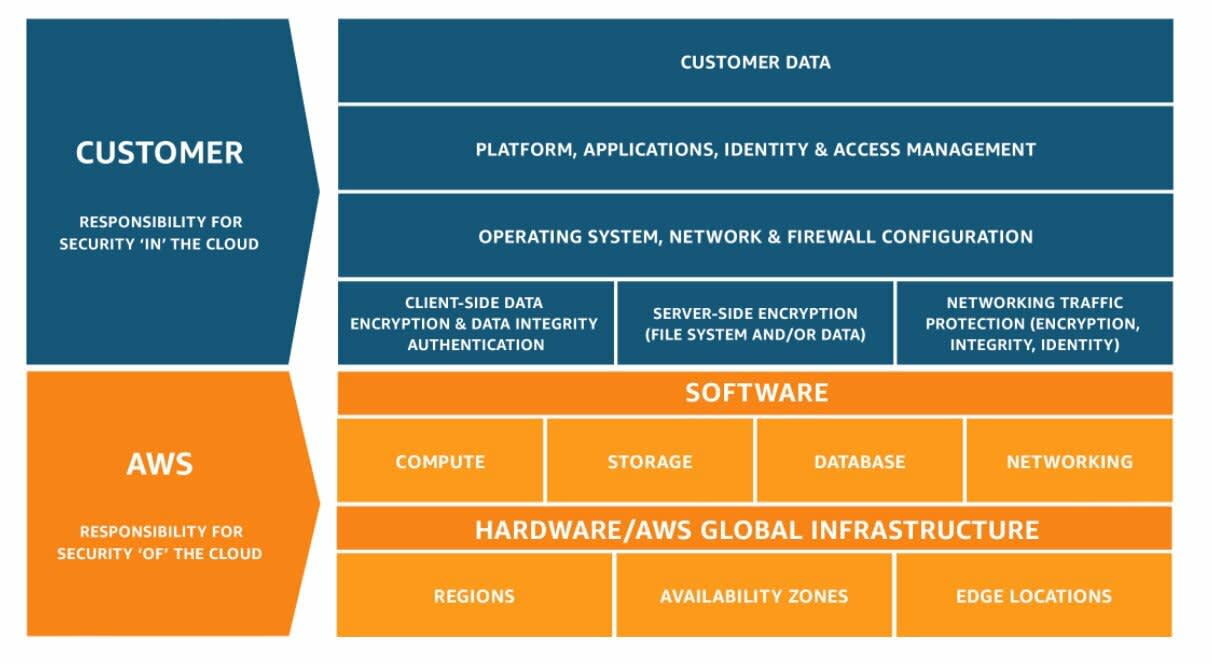Learn the AWS Shared Responsibility Model
Learning Objectives
After completing this unit, you will be able to:
- Define the AWS’s responsibilities in the shared responsibility model.
- Define your responsibility in the shared responsibility model.
Before you complete this module, make sure you complete AWS Cloud. The work you do here builds on the concepts you learn in there.
In the AWS Cloud module, you learned about using cloud computing for your cat photo sharing application in AWS. When you begin working with the AWS Cloud, managing security and compliance is a shared responsibility between AWS and you. To depict this shared responsibility, AWS created the shared responsibility model. This distinction of responsibility is commonly referred to as security of the cloud, versus security in the cloud.

What Is AWS Responsible For?
AWS is responsible for security of the cloud. This means AWS is required to protect and secure the infrastructure that runs all the services offered in the AWS Cloud. AWS is responsible for:
- Protecting and securing AWS Regions, Availability Zones, and data centers, down to the physical security of the buildings
- Managing the hardware, software, and networking components that run AWS services, such as the physical server, host operating systems, virtualization layers, and AWS networking components
The level of responsibility AWS has depends on the service. AWS classifies services into three different categories. The following table provides information about each, as well as the AWS responsibility.
Category |
Examples of AWS Services in the Category |
AWS Responsibility |
|---|---|---|
Infrastructure services |
Compute services, such as Amazon Elastic Compute Cloud (Amazon EC2) |
AWS manages the underlying infrastructure and foundation services. |
Container services |
Services that require less management from the customer, such as Amazon Relational Database Service (Amazon RDS) |
AWS manages the underlying infrastructure and foundation services, operating system, and application platform. |
Abstracted services |
Services that require very little management from the customer, such as Amazon Simple Storage Service (Amazon S3) |
AWS operates the infrastructure layer, operating system, and platforms, as well as server-side encryption and data protection. |
You learn more about all the services mentioned in the previous table later on in this trail.
What Is the Customer Responsible For?
You’re responsible for security in the cloud. When using any AWS service, you’re responsible for properly configuring the service and your applications, as well as ensuring your data is secure.
The level of responsibility you have depends on the AWS service. Some services require you to perform all the necessary security configuration and management tasks, while other more abstracted services require you to only manage the data and control access to your resources. Using the three categories of AWS services, you can determine your level of responsibility for each AWS service you use.
Category |
AWS Responsibility |
Customer Responsibility |
|---|---|---|
Infrastructure services |
AWS manages the infrastructure and foundation services. |
You control the operating system and application platform, as well as encrypting, protecting, and managing customer data. |
Container services |
AWS manages the infrastructure and foundation services, operating system, and application platform. |
You are responsible for customer data, encrypting that data, and protecting it through network firewalls and backups. |
Abstracted services |
AWS operates the infrastructure layer, operating system, and platforms, as well as server-side encryption and data protection. |
You are responsible for managing customer data and protecting it through client-side encryption. |
Due to the varying level of effort, it’s important to consider which AWS service you use and review the level of responsibility required to secure the service. It’s also important to review how the shared security model aligns with the security standards in your IT environment, as well as any applicable laws and regulations.
It’s important to note that you maintain complete control of your data and are responsible for managing the security related to your content. Here are some examples of your responsibilities in context.
- Choosing a Region for AWS resources in accordance with data sovereignty regulations
- Implementing data protection mechanisms, such as encryption and managing backups
- Using access control to limit who has access to your data and AWS resources
Wrap Up
The shared responsibility model defines the level of responsibility for you and AWS. When you create your application, you’ll need to understand this model to know what security controls need to be implemented for the AWS services you use.
In the next unit, you create an AWS account and explore a few key concepts of security on AWS.
Resources
